Jasper: Properties, Uses and Virtues
Jasper: Precious stones and rocky adventures!
Jasper, a bewitching gem of varied colors, has captured the human imagination with its captivating beauty and metaphysical appeal. With shades ranging from vibrant reds to soothing greens, jasper is a testament to the Earth’s artistry. Join us on a fascinating journey to discover the geological formation, historical significance and bewitching varieties of jasper, each with its own unique charm and energy.
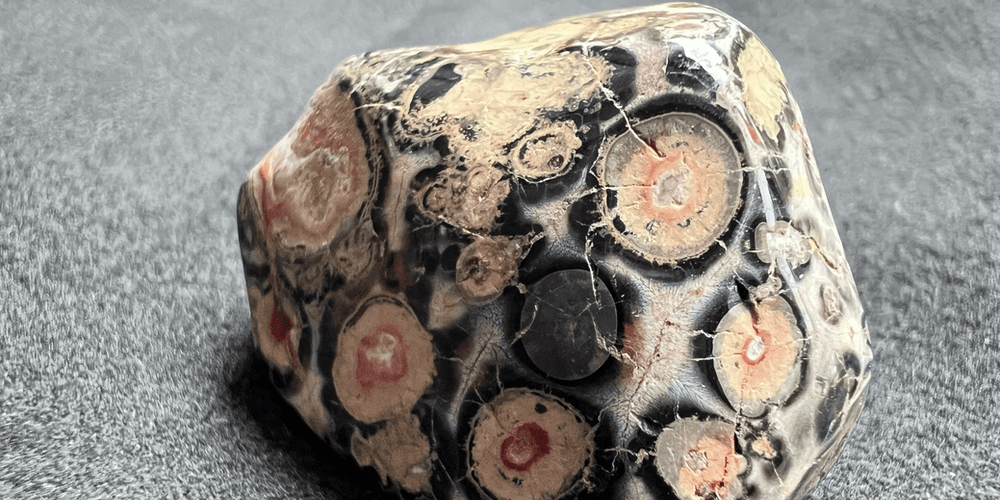
Jaspe: Table of contents
- Jasper Geological Formation
- Rough Jasper – Natural Beauty
- Sources – Exploring the worldwide origins of Jasper
- Historical Significance of Jasper – Through the Ages
- Metaphysical Properties of Jasper – A journey into the spiritual realm
- Jasper Varieties: distinctive colors and origins
- Colors of Jasper – A Kaleidoscope
- Durability and Wearability of Jasper
- Jasper Enhancements and Treatments – Oil and Controversy
- Synthetic Jasper – Nature in the Lab
- Imitations of Jasper – Ensuring authenticity
- Jasper Care – Preserving natural beauty
Jasper Geological Formation
Jasper is a variety of polycrystalline quartz, opaque in contrast to translucent to semi-transparent agate, formed over millions of years by the interaction of silica-rich solutions with various host rocks. This enchanting gem is found in sedimentary rocks, volcanic formations and other geological settings, highlighting the Earth’s enduring creativity in creating this treasure.
Rough Jasper – Natural Beauty
Like many polycrystalline materials, jasper has no specific crystalline form and is composed of many small crystals, contributing to its unique appearance.
Sources – Exploring the worldwide origins of Jasper
Jasper can be found in many parts of the world, including Madagascar, Brazil, Australia and the United States. Each location produces jasper with distinct colors and patterns, making this gem a true global gemological treasure.
Historical Significance of Jasper – Through the Ages
Jasper has a rich and fascinating historical significance that dates back thousands of years, making it a gem deeply rooted in the cultures and beliefs of various civilizations. Its enduring beauty and captivating colors have attracted human attention since ancient times, leading to its widespread use in jewelry, artifacts and ceremonial objects.
Ancient Egypt:
In ancient Egypt, jasper was considered a protective stone with strong links to the afterlife. It was often used to create amulets, seals and scarabs to protect the soul on its journey to the afterlife. The Egyptians also associated jasper with the sun, linking its glowing hues to the sun’s rays and regarding it as a symbol of strength and vitality.
Antiquity:
In the ancient world, jasper was also highly prized by the Greeks and Romans. They admired its varied colors and patterns and used it to create intricate cameos, intaglios and other decorative pieces. Jasper gems were often carved with elaborate designs, depicting mythical figures, gods and other symbols of power and protection. These engraved jasper stones were worn as amulets or used as seals, signifying authority and status.
Ancient Asia:
In ancient Asian cultures such as China and India, jasper was considered a sacred stone with powerful healing properties. It was used in traditional medicine and rituals to promote health, longevity and spiritual well-being. The Chinese considered jasper a balancing stone, believed to harmonize yin and yang energies, promoting harmony and stability in life.
Amerindian culture:
In Native American cultures, jasper had deep spiritual significance and was used in ceremonial and healing rituals. Different tribes worshipped different colors of jasper, attributing unique qualities to each variety. Red jasper, for example, was said to link its wearer to the energies of the earth, instilling courage and determination.
Throughout history:
Throughout history, jasper has also been associated with various symbolic meanings. It has been considered a stone of protection, grounding and courage, strengthening the bond with the earth and offering a sense of stability during difficult times. Jasper’s connection with the earth and its nourishing energies has led to its use in fertility rituals and to promote abundance and prosperity.
Metaphysical Properties of Jasper – A journey into the spiritual realm
Jasper’s metaphysical properties are as diverse as its colors. Often associated with down-to-earth energies, jasper is reputed to bring tranquility and balance to its wearer. Different varieties of jasper are believed to resonate with specific chakras, enhancing different aspects of spiritual growth and healing. Whether for stability, strength or wisdom, jasper has been embraced by spiritual seekers for its powerful metaphysical energies.
Jasper Varieties: distinctive colors and origins
Jasper, a gem with a kaleidoscope of bewitching colors and patterns, is a treasure trove of diversity. Most of the names given to Jasper come from its colors or origins. Here are some of the most sought-after jaspers, each with its own unique charm and distinctive characteristics.
- Red jasper: Radiating warm, fiery hues, red jasper is a symbol of strength and endurance. Its deep crimson tones evoke a connection to the energies of the earth, offering a sense of rootedness and stability to the wearer. Often associated with vitality and passion, red jasper is said to instill courage and determination, enabling individuals to overcome challenges and embrace life’s journey with renewed vigor.
- Star jasper: Star jasper, also known as stellar jasper, is a recent variety of jasper from Mexico, distinguished by its luminous, sparkling patterns that resemble a starry sky. These patterns resemble twinkling stars against the backdrop of the night sky, creating a beautiful and unique visual effect.
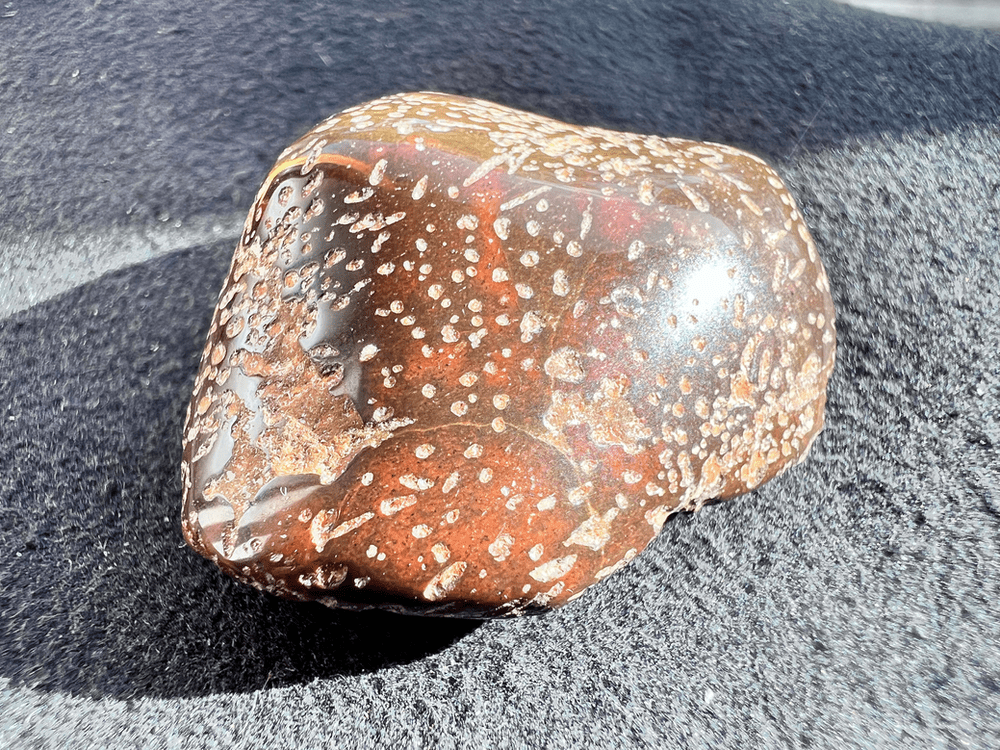
- Banded jasper: A striking beauty characterized by its distinctive banded patterns, banded jasper presents a palette of colors and layers. Stripes in different shades create a visual feast, reminiscent of the Earth’s geological wonders. This variety of jasper is revered for its harmonizing energies, which are believed to promote a sense of balance and serenity, allowing energies to flow smoothly throughout life.
- Leopard jasper: Leopard jasper is a natural stone named for its distinctive patterns, which evoke the spotted fur of a leopard. This stone is generally composed of shades of brown, beige, gray and black, with black or dark brown spots that resemble leopard’s footprints.
- Kaleidoscope jasper: As its name suggests, kaleidoscope jasper bewitches with a myriad of colors, patterns and shapes, similar to the intricate patterns seen through a kaleidoscope. This fascinating variety features a harmonious blend of earthy tones and vivid colors, capturing the essence of nature’s artistic palette. Kaleidoscope jasper is said to stimulate creativity, encouraging individuals to see life in a new, inspired light.
- Poppy jasper: Revealing the intense, vibrant colors of poppies in a field, poppy jasper exudes an invigorating energy. Its mix of reds, oranges and browns reflects the vitality of nature’s spring awakening. Poppy jasper is believed to promote joy and exuberance, awakening the senses and encouraging an enthusiasm for life. Its vivacious appearance reminds us of the beauty and excitement that life has to offer.
- Kambaba or Crocodile Jasper: Crocodile jasper, also known as kambaba, evokes images of swirling patterns reminiscent of a crocodile’s textured skin. These are actually fossilized stromatolites. Its hues range from dark green to black, with irregular bands of light green or yellow stretching across the stone, creating a distinctive pattern. Crocodile jasper is a stone that embodies strength, protection and connection to nature.
- Ocean Jasper: Evoking the tranquil essence of ocean waters, ocean jasper is an enchanting variety with soothing shades of blues, greens and whites. It often features captivating orbicular patterns reminiscent of sea foam and the gentle rhythm of waves. Ocean jasper is revered for its soothing properties, believed to relieve stress and bring a sense of tranquility and emotional healing.
- Mookaite: Native to the Australian outback, mookaite is a captivating variety of jasper displaying a vibrant palette of earthy colors, including mustard yellows, blazing oranges and deep purples. Named after the Mooka Creek in Western Australia, this gemstone is cherished for its nourishing, grounding energies. Mookaite is believed to inspire a deeper connection with nature, offering strength and stability during times of change and transformation.
- Dalmatian jasper: Embodying the playfulness of its namesake, Dalmatian jasper has a whimsical appearance with scattered black flecks on a creamy base. This variety is reminiscent of the famous Dalmatian dog, evoking feelings of joy, innocence and childlike wonder. Dalmatian jasper is believed to promote a positive outlook on life, encouraging individuals to let go of old patterns and embrace their true nature.
- Blood Jasper: Blood Jasper is not considered to be a Jasper variety in its own right, but generally a Chalcedony variety comprising mostly Jasper. Sometimes considered a variety apart and sometimes called Heliotrope, it is commonly linked to the sign of Aries and considered one of the birthstones of the month of March.
Other varieties include, but are not limited to: Picasso jasper, imperial jasper, landscape jasper, pink jasper, gray jasper, blue jasper and kiwi jasper.
Colors of Jasper – A Kaleidoscope
The jasper palette encompasses a broad spectrum of colors, from earthy reds and yellows to vibrant greens and blues. The hues of this gem evoke the beauty of nature, making jasper an excellent choice for earth-inspired jewelry.
Durability and Wearability of Jasper
Jasper’s durability makes it a suitable gemstone for jewelry, with a hardness of between 6.5 and 7 on the Mohs scale. Its robust nature ensures that jasper can withstand daily use, preserving its natural appeal and charm for generations to come.
Jasper Enhancements and Treatments – Oil and Controversy
Jasper, like many gemstones, can undergo various treatments and enhancements to improve its appearance or create specific color effects. While some treatments are widely accepted and considered commonplace, others may be more controversial or require disclosure to maintain ethical practices in the gemstone industry.
- Waxing or oiling: A common treatment for jasper is to apply wax or oil to the surface of the stone. This treatment enhances the brilliance and smoothness of the gem, giving it a more polished, attractive appearance. Waxing and oiling are considered acceptable and standard practices for certain types of jasper.
- Heat treatment: Heat treatment is a common improvement used to intensify the color of certain varieties of jasper, particularly red jasper. The process involves exposing the gemstone to controlled heat, which can darken its color, making it more brilliant. Heat treatment can also be used to modify the appearance of banded jasper, accentuating the contrast between its bands.
- Dyeing: Dyeing is a controversial treatment for jasper, as it involves the use of artificial coloring agents to change or enhance the gemstone’s color. Dyed jasper may have more vivid or unusual shades that do not occur naturally in the gem. It is essential that sellers disclose whether a jasper has been tinted to ensure transparency and informed purchasing decisions.
- Stabilization: Some varieties of jasper, particularly those with porous or delicate structures, can be stabilized to improve durability and prevent damage. La stabilisation consiste à imprégner la pierre précieuse d’une résine ou d’un polymère incolore, renforçant sa structure et améliorant sa capacité à résister à l’usure.
- Impregnation: Similar to stabilization, impregnation involves infusing jasper with a clear resin or other substances to improve its appearance or durability. This treatment can intensify the gem’s colors, making it more visually appealing while preserving its natural patterns and characteristics.
It is essential that gem dealers and sellers are transparent about any treatments or enhancements that jasper may have undergone. Proper disclosure enables buyers to make informed decisions and ensures that the gemstone’s value and authenticity are properly represented. Ethical practices within the gemstone industry focus on providing buyers with all necessary information about a gem’s processing history to promote trust and fair trade.
Synthetic Jasper – Nature in the Lab
Unlike some gemstones, synthetic jasper is not common on the market. Most of the “synthetic jasper” available is in fact an imitation made from other materials. As a result, buyers need to be careful to ensure they are buying genuine jasper.
Imitations of Jasper – Ensuring authenticity
Jasper can be imitated using tinted agate or glass to reproduce its vibrant colors and patterns. To guarantee authenticity, it’s essential to buy jasper from reputable, certified gem dealers who can verify its origins.
Jasper Care – Preserving natural beauty
Caring for jasper jewelry is essential to preserving its timeless beauty.
- Avoid exposing them to aggressive chemicals and store them separately to avoid scratches.
- Gently clean jasper with mild soapy water and a soft brush, preserving its enchanting shine and natural charm.
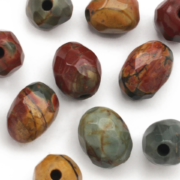
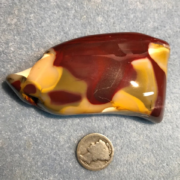
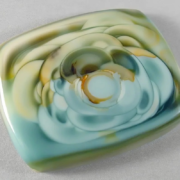

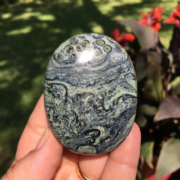
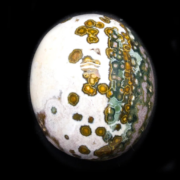


Leave a Reply
Want to join the discussion?Feel free to contribute!